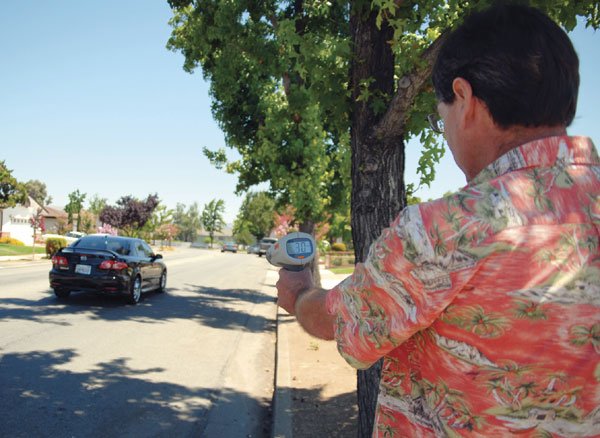Welburn Avenue is littered with war stories. Everyone has one:
Cars battered and dented, cats killed, fender-benders as residents
try feebly to back out onto the busy street, a once-sleepy
cul-de-sac now funneling a stream of cars west from the
freeway.
Rose Lepitich has two: Cars have barreled into her yard twice,
once nearly reaching her bedroom window.
Gilroy – Welburn Avenue is littered with war stories. Everyone has one: Cars battered and dented, cats killed, fender-benders as residents try feebly to back out onto the busy street, a once-sleepy cul-de-sac now funneling a stream of cars west from the freeway.
Rose Lepitich has two: Cars have barreled into her yard twice, once nearly reaching her bedroom window.
“It’s stuff that’s been going on forever,” said Ruben Villagran, a Welburn Avenue resident, gesturing angrily toward the road. “Even if we went to City Council – it didn’t matter.”
Until now, Tim Gavin hopes.
Aggravated by the traffic rumbling past his home, Gavin spent a year documenting the problem, transforming a grab-bag of neighborhood gripes into a bonafide mission. His goal: Push city engineers to divert traffic from Welburn Avenue, as part of a citywide Neighborhood Traffic Management Plan.
Gavin pored over the Highway Capacity Manual – “the Bible of traffic management,” he said – catalogued city traffic counts and even produced a DVD with time-stamped snippets of a 24-hour stretch of Welburn Avenue traffic. He tosses off traffic terminology with ease, nimbly explaining the difference between collectors – surface streets serving neighborhood traffic – and arterials, which link far-flung areas. His Welburn Avenue block is a collector, according to city policy, but he doubts that the delivery trucks rolling through are bound for nearby homes.
According to Gavin’s report, his stretch of Welburn Avenue handles three to six times as many trips-per-household as comparable Gilroy neighborhoods, and averages one vehicle every nine seconds. In a list of 2005 traffic flows, Welburn Avenue between Wayland Lane and Church Street ranks higher than any other collector and 60 arterial roads.
“It’s nonstop,” said Nathan Ibanez, a truck driver who lives on Welburn Avenue. “Everybody just flies through. We don’t let our little girls come outside, and we can’t let our dogs out front.”
Neighbors echo Ibanez’ words: Domingo Perales lost three cats to Welburn Avenue traffic in just 18 months. Debra Taylor’s Pekinese escaped from her yard, and was run down. She and her husband Tony plan to move. Esther Tamayo reports waiting seven or eight minutes in the morning, just to back up from her driveway. She’s been hit twice. Sometimes, she just decides to stay home.
“No street should be used for something it’s not designed for,” Gavin said. As he spoke, an 18-wheeler lumbered past his home, drowning out all conversation. Gavin raised his eyebrows, then added, “You tell me what this is being used for.”
East-west connectors
could cut down traffic
Don Dey, the city traffic engineer, said Gavin’s work is impressive, but his quest is likely futile. Because Welburn Avenue is the only continuous link between U.S. 101 and Santa Teresa Boulevard, the bulk of traffic will use it to cut across town – regardless of how the road is designated on city plans. The only way to cut down traffic on Welburn Avenue is to open up other east-west routes.
“The functionality of a roadway is dictated by its connectivity to other roadways,” said Dey, concluding, “Welburn is serving the function for which it was laid out … There’s nothing that I could suggest that would reduce the volume of traffic.”
That’s more or less what Dey told Gavin last June, when he first approached the engineer. Gavin didn’t buy it.
“To just be blown off was not acceptable,” Gavin said. “And I had to be able to back up everything I said.”
To prove that Welburn Avenue is being used – Gavin might say abused – for cut-through traffic, Gavin determined the number of trips-per-household, using household counts and traffic flows calculated by the city. He photographed every truck and bus that passed his home during a 24-hour period, got 48 neighbors to sign a petition and surveyed nearby cities to compare how they handled residents’ gripes about traffic, then stacked every last chart, graph and photo into 10 neat binders, bound for City Hall. It took him one week working full-time to put his presentation together, he said, after months of research.
Traffic calming projects used elsewhere in Gilroy
Two Gilroy neighborhoods have already been targeting for “traffic calming,” defined by the national Institute of Transportation Engineers as efforts to reduce the negative impacts of car use, alter driver behavior and make streets pedestrian-friendly. To keep Sixth Street safe for walkers and bikers, the city plans to install curb extensions, narrowing the roadway without diverting traffic. To the north, on Sunrise Drive, traffic islands and a stop sign have been installed to slow speeders.
Similar curb extensions could be installed on Welburn Avenue, Dey wrote in response to Gavin’s report, but there’s no designated funding to install them on Gavin’s street. Gavin has complained that without objective criteria to gauge whether neighborhood traffic is excessive, there’s no fair way to select which streets to calm. He argues that Sixth Street, which is bracing for heavier traffic when the new Camino Arroyo Bridge links Kaiser Permanente to Wal-Mart, is being prioritized over Welburn Avenue.
Not all City Council members had read Gavin’s materials by press time Thursday, but City Councilman Peter Arellano said he was already well-acquainted with Welburn Avenue traffic.
“It’s unfortunate, no question,” Arellano said. “But there are no simple answers. If we divert it from one neighborhood, we may just put it into another.”
Council member Craig Gartman said Gavin “hit the nail on the head,” but little can be done to reduce Welburn Avenue traffic volumes until new east-west routes open through Gilroy, years from now.
But Mayor Al Pinheiro said Welburn Avenue residents may not have to wait that long. Pinheiro met with Gavin Thursday morning at his home, and promised to meet with Dey and City Administrator Jay Baksa today to start tackling the issue.
“We identified some short-term things he felt could really help,” said Pinheiro. “If there are short-term things, i.e. stop signs, I think we should look at it.”
For his part, Gavin is ready to take a breather, one year after he kicked off his crusade.
“I finally have time to mow my lawn,” he joked.















